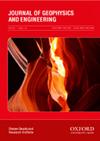Evaluating imaging uncertainty associated with the near surface and added value of vertical arrays using Bayesian seismic refraction tomography
IF 1.7
3区 地球科学
Q3 GEOCHEMISTRY & GEOPHYSICS
引用次数: 1
Abstract
Traditional tomographic methods do not consider the uncertainties associated with near-surface velocities and static corrections and provide a deterministic solution to the estimation problem. However, these uncertainties significantly impact structural mapping and interpretation of seismic imaging results. On the other hand, Bayesian first-arrival tomography provides multiple near-surface models that fit observed traveltimes equally well and enable the study of potential solution distributions. We demonstrate this approach on a complex synthetic near-surface model, representative of arid environments, to quantify associated velocity and statics uncertainties. We evaluate two different parameterizations for subsurface velocities in the context of near-surface Bayesian tomography: Voronoi tessellation with natural neighbor interpolation and the more conventional Delaunay triangulation with linear interpolation. Our analysis shows that the Voronoi cell parameterization with natural neighbor interpolation is more appropriate for this problem. Finally, the new approach is applied to compare two alternative acquisition geometries comprising conventional surface receivers and surface receivers augmented with vertical receiver arrays. The results demonstrate that adding vertical receiver arrays to conventional surface receivers can significantly reduce the near-surface velocity uncertainty and thus increases the accuracy of the seismic imaging results. Furthermore, the study shows that Bayesian tomography can be used as a tool for evaluating different source and receiver geometries during the acquisition design stage.利用贝叶斯地震折射层析成像技术评估近地表成像的不确定性和垂直阵列的附加价值
传统的断层摄影方法没有考虑与近地表速度和静态校正相关的不确定性,并且为估计问题提供了确定性的解决方案。然而,这些不确定性极大地影响了结构测绘和地震成像结果的解释。另一方面,贝叶斯初至层析成像提供了多个近表面模型,这些模型同样好地拟合观测到的旅行时间,并能够研究潜在的解分布。我们在代表干旱环境的复杂合成近地表模型上演示了这种方法,以量化相关的速度和静力学不确定性。在近表面贝叶斯层析成像的背景下,我们评估了地下速度的两种不同参数化:具有自然邻域插值的Voronoi镶嵌和具有线性插值的更传统的Delaunay三角测量。我们的分析表明,带有自然邻域插值的Voronoi单元参数化更适合于这个问题。最后,将新方法应用于比较两种可选的采集几何结构,包括传统的地面接收器和用垂直接收器阵列增强的地面接收器。结果表明,在常规地面接收器的基础上增加垂直接收器阵列可以显著降低近地表速度的不确定性,从而提高地震成像结果的准确性。此外,该研究表明,在采集设计阶段,贝叶斯断层扫描可以用作评估不同源和接收器几何形状的工具。
本文章由计算机程序翻译,如有差异,请以英文原文为准。
求助全文
约1分钟内获得全文
求助全文
来源期刊

Journal of Geophysics and Engineering
工程技术-地球化学与地球物理
CiteScore
2.50
自引率
21.40%
发文量
87
审稿时长
4 months
期刊介绍:
Journal of Geophysics and Engineering aims to promote research and developments in geophysics and related areas of engineering. It has a predominantly applied science and engineering focus, but solicits and accepts high-quality contributions in all earth-physics disciplines, including geodynamics, natural and controlled-source seismology, oil, gas and mineral exploration, petrophysics and reservoir geophysics. The journal covers those aspects of engineering that are closely related to geophysics, or on the targets and problems that geophysics addresses. Typically, this is engineering focused on the subsurface, particularly petroleum engineering, rock mechanics, geophysical software engineering, drilling technology, remote sensing, instrumentation and sensor design.
 求助内容:
求助内容: 应助结果提醒方式:
应助结果提醒方式:


